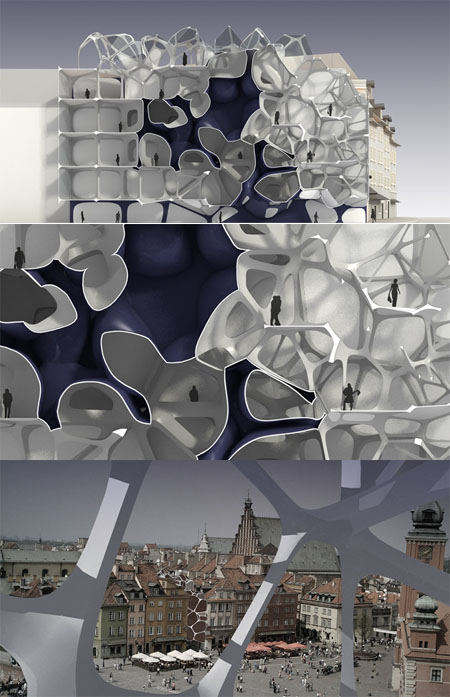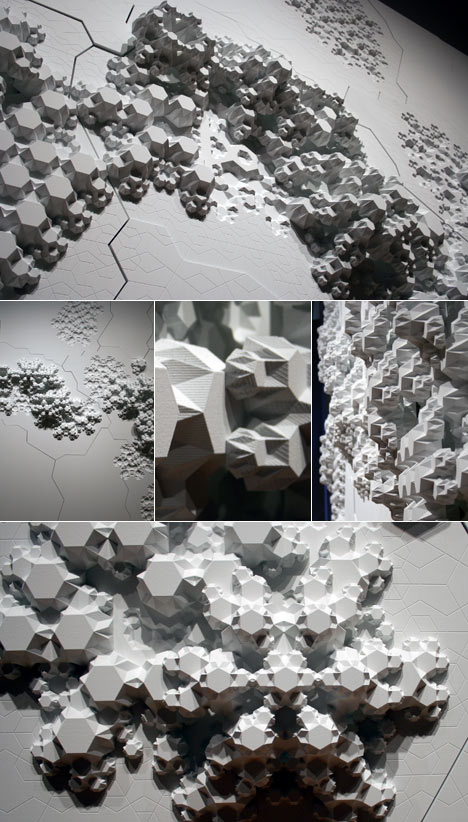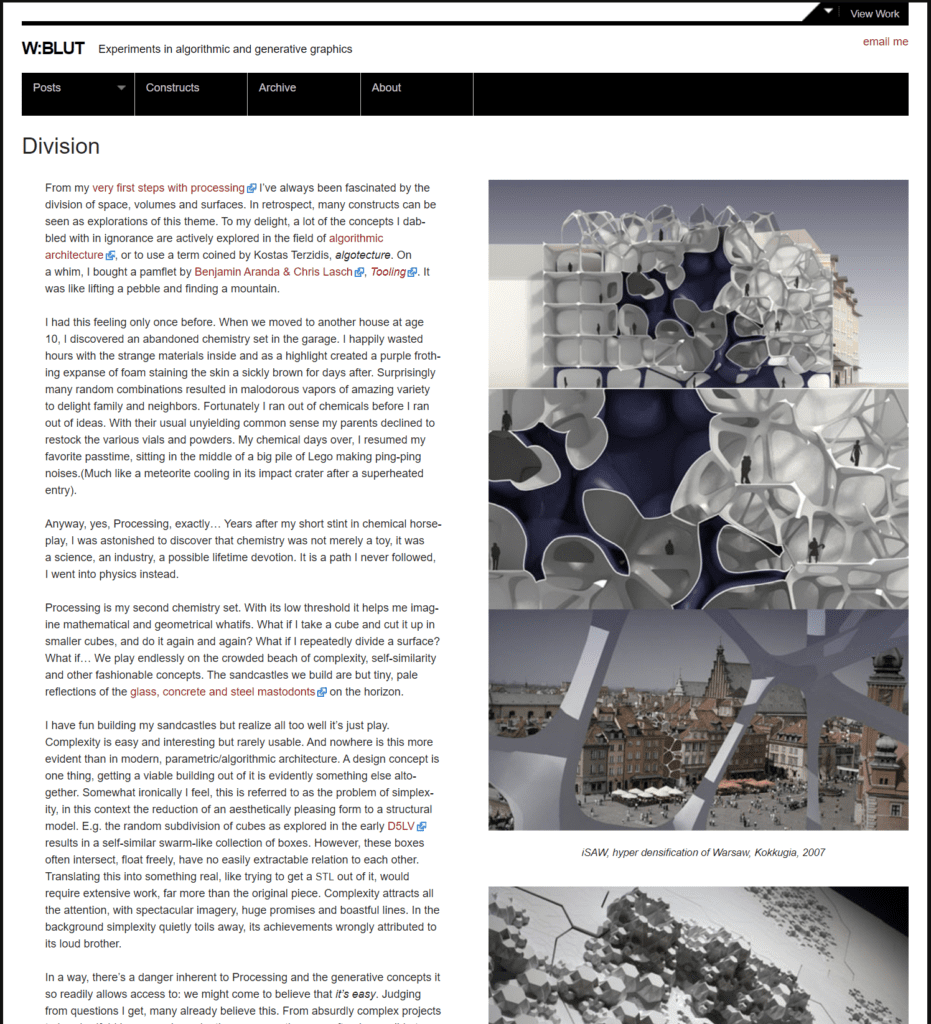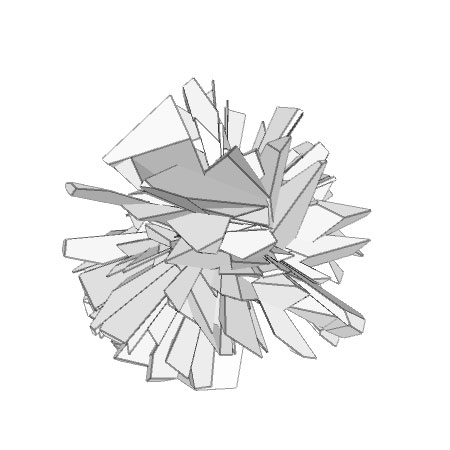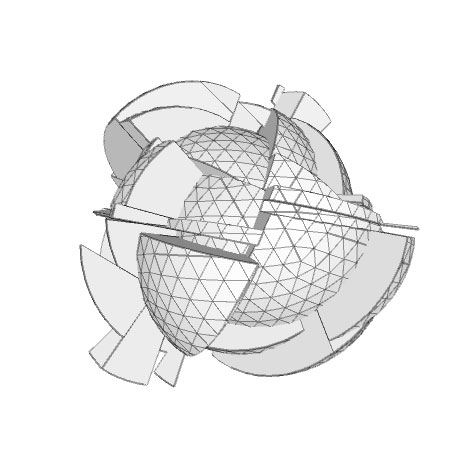From my very first steps with processing, I’ve always been fascinated by the division of space, volumes and surfaces. In retrospect, many constructs can be seen as explorations of this theme. To my delight, a lot of the concepts I dabbled with in ignorance are actively explored in the field of algorithmic architecture, or to use a term coined by Kostas Terzidis, algotecture. On a whim, I bought a pamflet by Benjamin Aranda & Chris Lasch, Tooling. It was like lifting a pebble and finding a mountain.
I had this feeling only once before. When we moved to another house at age 10, I discovered an abandoned chemistry set in the garage. I happily wasted hours with the strange materials inside and as a highlight created a purple frothing expanse of foam staining the skin a sickly brown for days after. Surprisingly many random combinations resulted in malodorous vapors of amazing variety to delight family and neighbors. Fortunately I ran out of chemicals before I ran out of ideas. With their usual unyielding common sense my parents declined to restock the various vials and powders. My chemical days over, I resumed my favorite passtime, sitting in the middle of a big pile of Lego making ping-ping noises.(Much like a meteorite cooling in its impact crater after a superheated entry).
Anyway, yes, Processing, exactly… Years after my short stint in chemical horseplay, I was astonished to discover that chemistry was not merely a toy, it was a science, an industry, a possible lifetime devotion. It is a path I never followed, I went into physics instead.
Processing is my second chemistry set. With its low threshold it helps me imagine mathematical and geometrical whatifs. What if I take a cube and cut it up in smaller cubes, and do it again and again? What if I repeatedly divide a surface? What if… We play endlessly on the crowded beach of complexity, self-similarity and other fashionable concepts. The sandcastles we build are but tiny, pale reflections of the mastodonts dreamt of by others.
I have fun building my sandcastles but realize all too well it’s just play. Complexity is easy and interesting but rarely usable. And nowhere is this more evident than in modern, parametric/algorithmic architecture. A design concept is one thing, getting a viable building out of it is evidently something else altogether. Somewhat ironically I feel, this is referred to as the problem of simplexity, in this context the reduction of an aesthetically pleasing form to a structural model. E.g. the random subdivision of cubes as explored in the early D5LV results in a self-similar swarm-like collection of boxes. However, these boxes often intersect, float freely, have no easily extractable relation to each other. Translating this into something real, like trying to get a STL out of it, would require extensive work, far more than the original piece. Complexity attracts all the attention, with spectacular imagery, huge promises and boastful lines. In the background simplexity quietly toils away, its achievements wrongly attributed to its loud brother.
In a way, there’s a danger inherent to Processing and the generative concepts it so readily allows access to: we might come to believe that it’s easy. Judging from questions I get, many already believe this. From absurdly complex projects to hundredfold increases in scale, the easy questions are often impossible to answer. (The hard questions are often quite easy.) I see similarities with the profileration of CGI industrial design models on the internet. Whole blogs thrive on pretty images of impossible to realize but beautiful concepts, reducing design to illustration.
Anyway, enough with the ramblings, I’ve got two small constructs, somewhat related to this post. My current fascination with the more practical side of generative algorithms leads me to rethink much of my past constructs. The aforementioned cube subdivision is fun but lacks a clear relationship between its elements, beyond the obvious self-similarity. Using my mesh code-in-progress, I sought an iterative subdivision algorithm that wouldn’t suffer from this kind of dissociative behavior. The end result should be interestingly complex but still be a single connected solid without selfintersection. I came up with two entries for this self-contest (actually three but I’m keeping the 3D Voronoi fractal for a bit later). They’re conceptually very simple so don’t expect anything revolutionary (or new), click on the images to go to the applet.
Note, this was in 2009, in 2022 applet means tiny apple and this type of code is not runnable online without rewriting it in something that is, so instead the links point to zip archives of offline code for processing 3.
